This week, how computer design helps surgeons reconstruct breasts, why mammalian cells modified to contain a single set of chromosomes can help us understand the roll of individual genes, and the Bling from Outer Space - why our Earthly gold has less terrestrial origins. Plus, infra-red camouflague that can hide a tank, and Australopithecus sediba - why an incredible fossil find may be the missing link in human ancestry.
In this episode
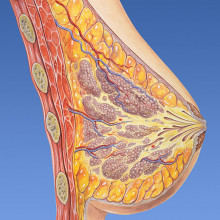
00:19 - Using CAD to reconstruct breast tissue
Using CAD to reconstruct breast tissue
This week, an international team of researchers reported how they have used computer-aided design (or CAD) to build a precise mould that can aid breast reconstruction in cancer patients.
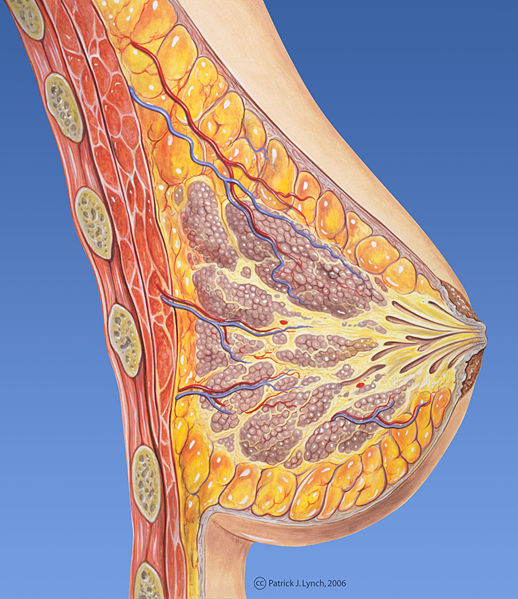 Publishing in the journal Biofabrication, the team took laser scans of healthy breasts and then used CAD software to produce a tailor-made scaffold in silicon. So far this model has only been used by surgeons as a visual guide for reconstruction operations. But the researchers hope that, very soon, this 3D scaffold can be used in combination with tissue engineering.
Publishing in the journal Biofabrication, the team took laser scans of healthy breasts and then used CAD software to produce a tailor-made scaffold in silicon. So far this model has only been used by surgeons as a visual guide for reconstruction operations. But the researchers hope that, very soon, this 3D scaffold can be used in combination with tissue engineering.
Lead author, Professor Dietmar Hutmacher from the Queensland University of Technology, hopes to use this CAD model as a scaffold for the patient's own cells to grow through, meaning that a purpose-grown implant can be placed back into the patient. The end result would be a new breast, made of the patient's own tissue that is perfectly symmetrical to the original.
The study also examined how satisfied the patients were following the operations where surgeons used this 3D model solely as a visual guide. The patients did indeed report a higher degree of satisfaction with the end result than those patients whose surgeons used more traditional methods - i.e. pen and paper. So if tissue engineering takes off, this technology could lessen the impact of mastectomy and can be extended to other applications where tissue needs to be replaced with accuracy.
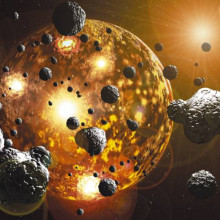
02:05 - How Earth got its gold
How Earth got its gold
Most of the bling with which we bedeck ourselves arrived on Earth aboard 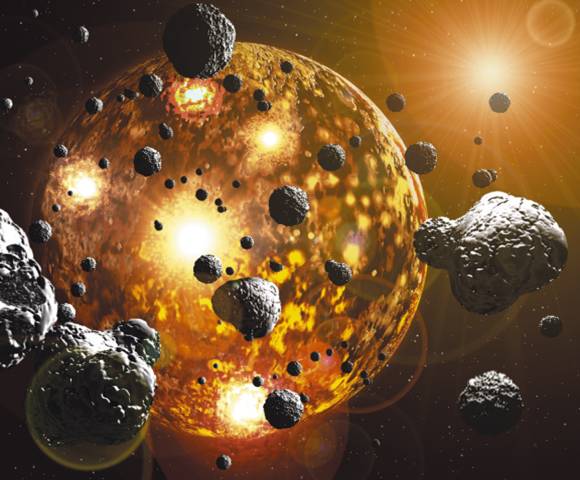 meteorites, recent research has revealed.
meteorites, recent research has revealed.
Our planet's early existence 4.5 billion years ago was a tempestuous one. Frequent massive collisions occurred between the proto-Earth and Moon- and Mars-sized objects that were accreting alongside our world from the disk of dust that spawned the solar system.
The energy of these impacts caused the Earth literally to melt. Inside the resulting giant molten ball, the heavy elements, like iron, sank towards the centre where they would later form what is now the planet's core. The lighter silicates then floated to the top like a cappuccino froth.
But therein lies the wrinkle, because heavy elements like gold and platinum are what are known as siderophiles. They readily combine with iron and therefore should have been pulled down into the core when the iron sank to the centre when the Earth was molten. Instead, these precious metals are actually about 1% more abundant in the Earth's outer layers than they ought to be.
One theory is that, at the very high pressures like those encountered within the planet's interior, the iron somehow releases its grip on the precious metals and they are squeezed out towards the surface. But whilst plausible, this explanation works for only certain elements so cannot be the whole story.
Now, by locating a geological needle in a haystack, scientists at the University of Bristol have found evidence to support a more elegant solution - that the Earth's gold-robbed surface was re-charged with the metal by a later, intense meteor shower after the planet had cooled.
Matthias Willbold and his colleagues, who have published the findings in Nature, reasoned that, when the Earth was molten, the element tungsten would have moved into the iron core, alongside the gold, leaving the planet's mantle relatively depleted in tungsten and enriched for another silicate-preferring element called hafnium-182. But hafnium-182 decays radioactively into tungsten-182. Therefore, the Earth's surface should have a relatively higher level of tungsten-182 than any meteorites that arrive later. So if rocks could be found from the early Earth that bear the predicted level of tungsten-182, this would support the hypothesis that the Earth was largely later re-surfaced by a batch of big meteorites, which would also have contained gold and other precious metals.
Incredibly, the team were able to locate such a set of samples. Rocks dating back 3.8 billion years, from Isua in Greenland, were a direct isotopic match.
"This strongly supports the depositing of a 'late veneer' of material added to the Earth's surface during a 500 million year phase called 'the late heavy bombardment'," says Willbold. "Some very large impactors struck the planet and re-coated the surface..but luckily in the case of these rocks in Greenland, not everywhere..."
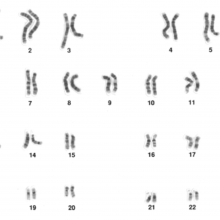
04:12 - Special Stem Cells With Single Sets of Chromosomes
Special Stem Cells With Single Sets of Chromosomes
Anton Wutz, Cambridge University
Diana - Also in the news this week, researchers here in Cambridge have created mammalian stem cells that only contain a single set of chromosomes. Most mammalian cells are diploid - they contain two copies of each chromosome. This is a complication for cell biologists and geneticists, hoping to study the function of individual genes. So joining us now to discuss this work is Dr. Anton Wutz. Hello.
Anton - Good evening and thank you for having me.
Diana - You're very welcome. Good to have you here. Can you start off with why would haploid mammalian cells be useful?
Anton - As you just said, basically, normal animal cells are diploid. Meaning, they have two chromosomes - one from the father and one from the mother. So basically, for each gene, there are two copies present in a cell. The genome contains all the information that is needed for the organism to develop and scientists have already obtained the sequence of all of those genes. However, we have to still figure out how these genes interact and what their overall contribution to development is. In that sense, what has proven very fruitful is just to look at what happens if you lose the function of a particular gene and look for what effect it has on development. If you're now trying to mutate genes in a diploid cell, it's very hard to hit both copies of the very same gene and for this reason, it's very hard to determine what the loss of this gene has as a consequence for the cell. In haploid cells, you have only a single chromosome set and hence, if you introduce a particular mutation, automatically, gene function is ablated and you can study the resulting effect.
Diana - I see. So, rather than having pairs, just by having this one chromosome with the gene that you want to study, it cuts out that extra factor of uncertainty.
Anton - Yeah. Basically, the genome has sort of a backup copy and that is lacking in the haploid case.
Diana - I see. So how have you gone about creating these haploid cells?

(c) Courtesy: National Human Genome Research Institute
' alt='23 pairs of human chromosomes' >Anton - It has been long known that in mammals you can activate the egg cells or oocyte and trick it into thinking it is fertilised without actually supplying a paternal genome via the sperm which would be introduced during normal fertilisation. So, by chemical manipulation, you can activate an egg cell and it will divide, and form an embryo with just the maternal chromosome set. And we have taken these embryos now and removed a small cell clump from the blastocyst stage and brought these into culture conditions which have been highly optimised over recent years by a number of groups. This has allowed us to induce proliferation into these haploid embryonic cells in culture and allow us to maintain a permanently proliferative, so growing cell line, in culture.
Diana - Have you put them into anything living?
Anton - The cell type we cultivated is referred to as an embryonic stem cell and conventional diploid embryonic stem cells have the ability to form all cell types of the embryo - of the mouse embryo - so we were very interested in what actually is the potential of a haploid embryonic stem cell. So we have introduced our stem cells back into the blastocysts of mice and looked if they can contribute to development and to a large degree, they do. So they can contribute to multiple organs and form different cell types in the embryo. However, we noticed that when they enter development and differentiate into functional cell types, they diploidise. So the genome content becomes more normal.
Diana - They end up with pairs of chromosomes rather than the single ones. Why do you think they revert back to that state?
Anton - We're not particularly clear on this but one thought is that in mammals normally, in female mammals, one of the two X chromosomes becomes inactivated and that's to compensate for the dosage to the male genome equivalent which has only a single X-chromosome but also a Y-chromosome. So one idea is that these cells would not be balanced so the normal developmental program is optimised for one active X-chromosome and two sets of autosomes. In our haploid case, we have a single X-chromosome as opposed to a single set of autosomes. So the X-chromosome dosage is too high by a factor of two. And we think that by duplicating the maternal chromosome set, these cells can now inactivate one of the two X-chromosomes again and so have a more normal gene expression pattern for development.
Diana - I see. So you can actually get cells acting sort of fairly normally even within this haploid state, but could this actually shed light on another area of genetics, on epigenetics?
Anton - Indeed, the possibility with the haploid would be now to investigate different pathways. This can range from cell signalling and metabolic pathways, but also of course, the interest in my group is geared towards epigenetic pathways, gene regulatory pathways that act in development. And I think we can tweak those cells by deriving suitable reporter constructs into situations so that they can select for epigenetic mutations and study how these processes are regulated particularly in mammals.
Diana - So this could really open a whole new field up in genetics. That's fantastic! Well thanks, Anton. That's Anton Wutz from Cambridge University and that work was published in the journal Nature this week.
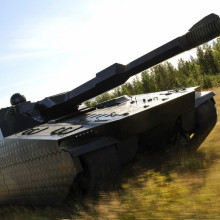
09:32 - Thermal camouflage
Thermal camouflage
Anything which is warm will glow, if it is very hot it will glow in visible light , but even at body temperature you are glowing with invisible infra red light. If you have ever watched a police show, you have probably seen footage from thermal cameras, which detect this light.
This glow isn't only a problem for criminals, but also for the military as a beautifully camouflaged tank in conventional light will still look just like a tank in the thermal infra-red.
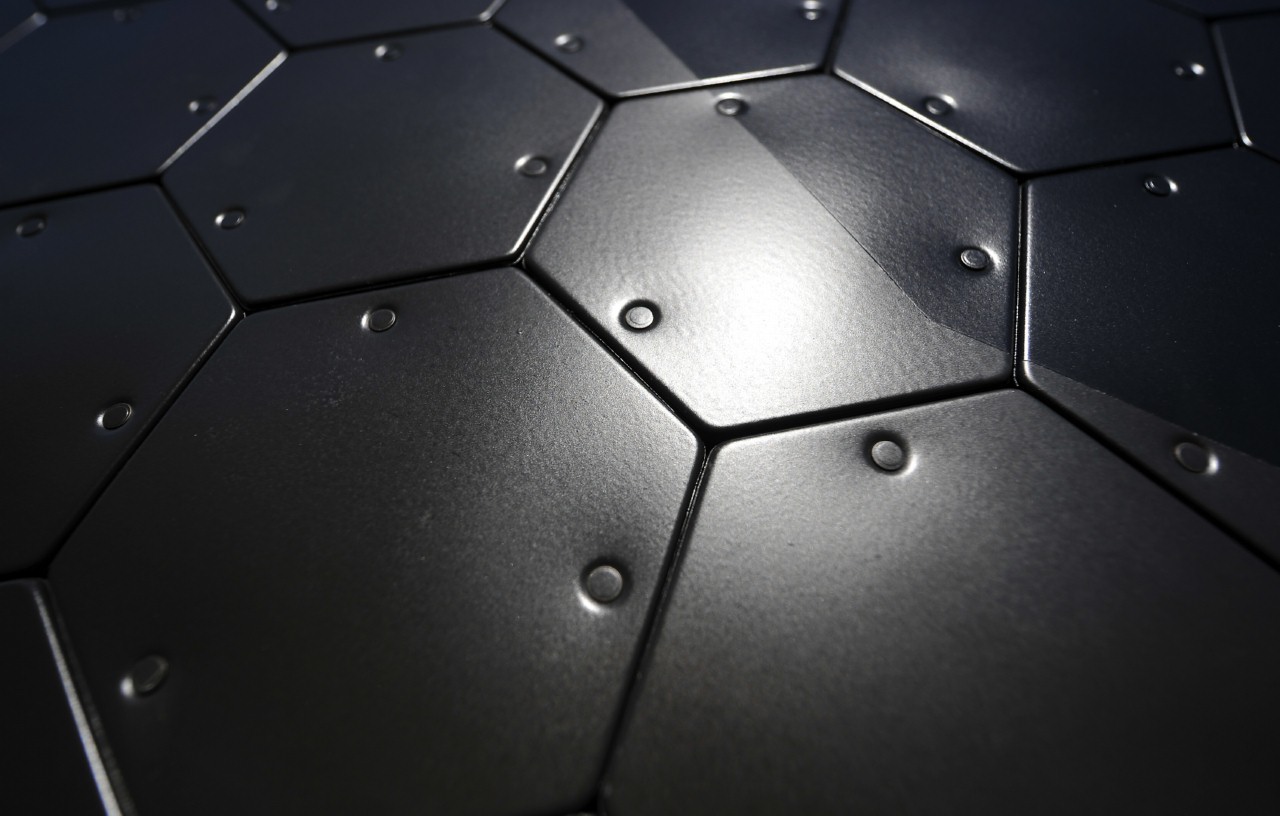 A part of BAE systems based in Sweden has developed a new form of camouflage which might help. It does this by covering your tank with lots of electrical heat pumps which I assume pump heat from or to the air which is transparent, so doesn't glow when hot. These pixels can heat or cool the surface of the tank very rapidly, and the temperature of each of the pumps can be indivdually be set so they work like pixels.
A part of BAE systems based in Sweden has developed a new form of camouflage which might help. It does this by covering your tank with lots of electrical heat pumps which I assume pump heat from or to the air which is transparent, so doesn't glow when hot. These pixels can heat or cool the surface of the tank very rapidly, and the temperature of each of the pumps can be indivdually be set so they work like pixels.
This means that the pixels can be set to mimic the temperature and pattern of the landscape behind the tank, or as this will never be perfect, it can be set to make a tank pretend to be a car or any other object.
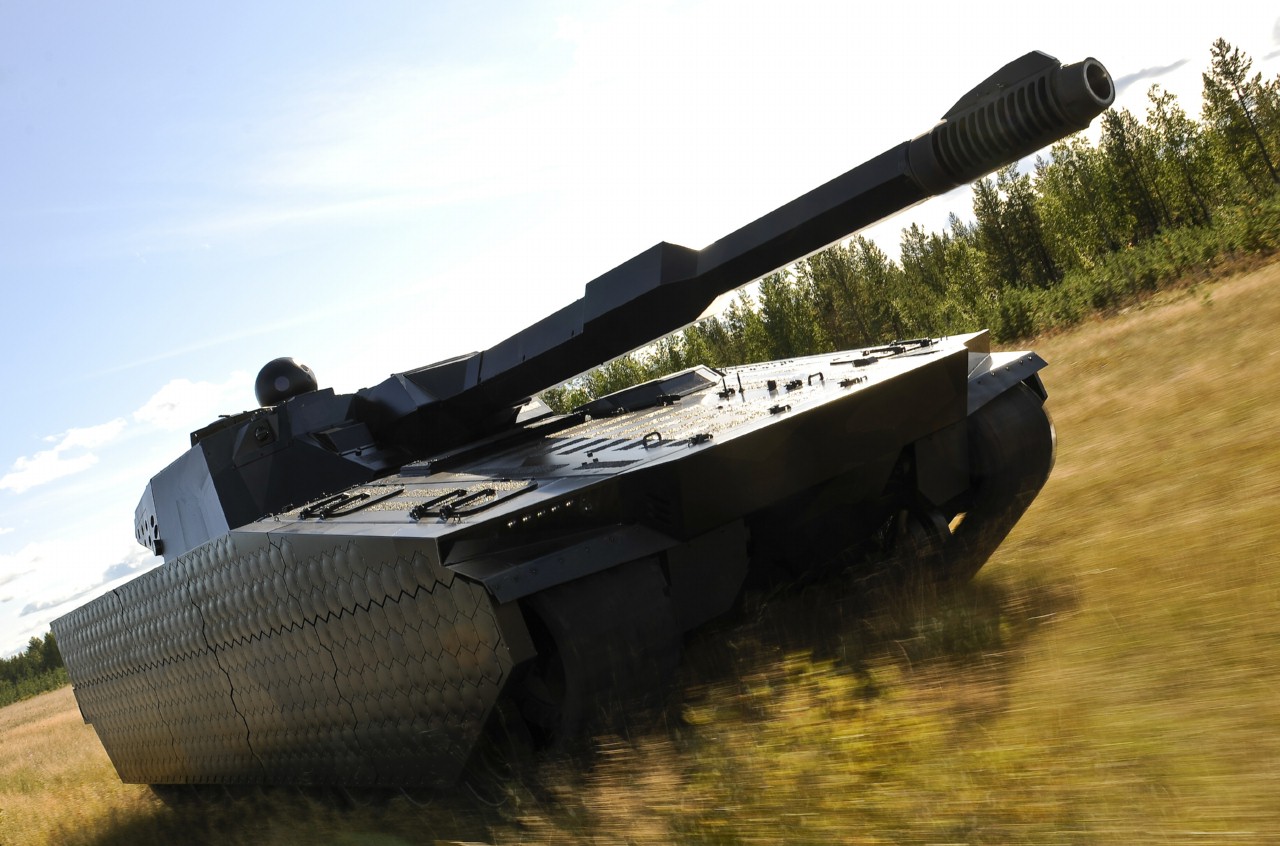 They also can make the pixels much larger for something like a ship when there is no point trying to make it invisible close to, and apparently the system is fairly robust, and actually add to the armour of the vehicle.
They also can make the pixels much larger for something like a ship when there is no point trying to make it invisible close to, and apparently the system is fairly robust, and actually add to the armour of the vehicle.
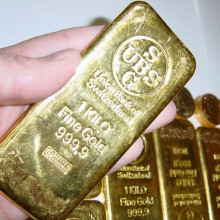
11:27 - The Bling from Outer Space
The Bling from Outer Space
This week, how computer design helps surgeons reconstruct breasts, why mammalian cells modified to contain a single set of chromosomes can help us understand the roll of individual genes, and the Bling from Outer Space - why our Earthly gold has less terrestrial origins. Plus, infra-red camouflague that can hide a tank, and Australopithecus sediba - why an incredible fossil find may be the missing link in human ancestry.
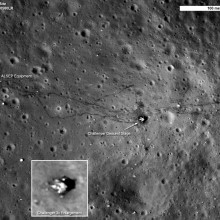
15:46 - Social weight Loss, Youthful plants and Moon Landings
Social weight Loss, Youthful plants and Moon Landings
Matthew During, Ohio state University, Iza Radeska, University of Wolverhampton, Johan Erlean, Stockholm University, Mark Robinson, NASA
Losing Weight the Social Way
Having an active social life could help with fat loss.
There are two forms of fat in the body - energy storing 'white' fat and energy burning 'brown fat'. Matthew During and colleagues at Ohio State University found that exposing mice to a challenging, socially-interactive environment with more mice, more space and toys resulted in a much leaner population.
"So when we looked at these animals and looked at fat, it was remarkably reduced. This total fat was reduced by that 50% to 70%. Fat changed from white fat to brown fat, making it resistant to obesity and giving it much greater long term health as well." Matthew During
Read more:
White to Brown Fat Phenotypic Switch Induced by Genetic and Environmental Activation of a Hypothalamic-Adipocyte Axis; Lei Cao, Eugene Y. Choi, Xianglan Liu, Adam Martin, Chuansong Wang, Xiaohua Xu, Matthew J. During; Cell Metabolism - 7 September 2011 (Vol. 14, Issue 3, pp. 324-338) DOI: 10.1016/j.cmet.2011.06.020
---
Protecting Probiotics
A new biopolymer could increase the effectiveness of probiotic friendly bacteria.
Until now, the main challenge facing probiotic manufacturers has been getting enough bacteria to survive the acidic conditions of the stomach.
But now, Iza Radecka's team from the University of Wolverhampton have developed a polymer to act as protective coating.
The increased survival time will allow greater numbers of bacteria make it through to the gut, to do their work.
"It's a bacterial polymer, it's water soluble, biodegradable, and edible. We, for example [put] uncoated and coated bacteria into simulated gastric juice. The ones which are not coated, after two hours there were none left but the ones which were coated with our polymer survived, intact, nearly 100%." Iza Radecka
Read more: New polymer research could boost probiotics industry -
Wolverhampton University Press release; This work was presented at the Society for General Microbiology's
Autumn conference in York, 5-7 September 2011
---
The Plant that doesn't get Old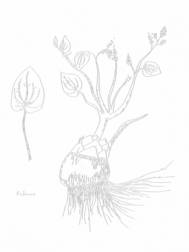
A herb found deep in the mountains of the Pyrenees can live for up to 300 years without showing any signs of ageing.
Johan Ehrlén from Stockholm University and colleagues studied 260 year old samples of the plant Borderea pyrenaica, to get further insight into the role and importance of ageing.
"We could find no evidence of decreased performance with age. No evidence of senescence. Growth and reproduction were constant over age and survival tended to increase with age. So actually, performance improved with age. The important finding is that there is a lot of theoretical arguments. If every organism has to senesce or whether selection can actually favour lack of senescence, and looking in different organs will sort out why senescence sometimes is important and why it's sometimes seems to be absent." Johan Ehrlén
Read more:
Garcia, Maria B; Dahlgren, Johan P; Ehrlén, Johan; No evidence of senescence in a 300-year-old mountain herb; Journal of Ecology; (2011); DOI: 10.1111/j.1365-2745.2011.01871.x
---
Personalised 3D Headsets
Sony have launched a personal 3D viewing headset as part of its increasing 3D technology range.

The headset was launched at the IFA 2011 consumer electronic show in Berlin this week with the head mounted display intended to give an immersive 3D experience.
The futuristic headset complete with headphones, uses two high definition screens which feed separate video to a viewers eyes to create a 3D illusion. But the gadget doesn't come cheap, with a current retail price of $785 dollars.
Read more:
"Pure immersion: the movie theatre that's just for you" - Sony press release
---
NASA Moon Landings
And finally, NASA have released high resolution images of the Apollo moon landings.
NASA's Lunar Reconaissance Orbitor captured the sharpest images ever taken of the Apollo 12, 14 and 17 landing.
Using low altitude narrow angle cameras, the images clearly show the movement of astronauts on the moons surface as well as the lunar rover, as NASA's Mark Robinson explained as he looks over the Apollo 17 landing.
"You can see very clearly both the astronaut tracks and the beautiful sharp and crisp parallel lines which are the tracks of the lunar roving vehicle. It's pretty neat, because you know what the RV looks like, if you squint really hard, you can begin to resolve the seats and the fact that the wheels are left turned slightly to the left." Mark Robinson
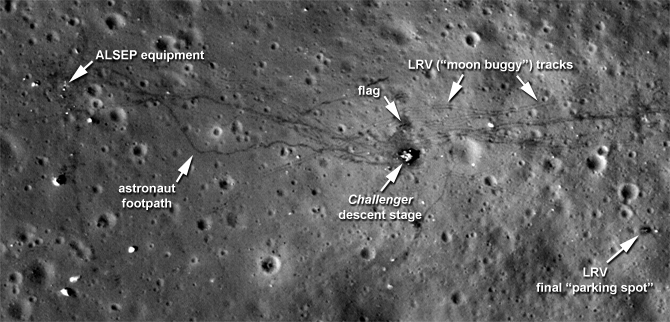 | 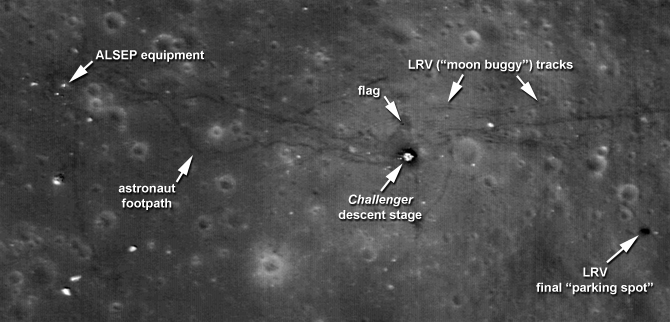 |
| You can view more images of the moon landings here. |
Related Content
- Previous How does a calculator work?
- Next Supercomputers & Super Computing










Comments
Add a comment